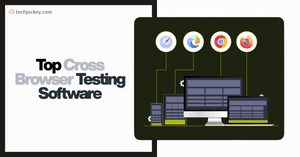What are Testing Tools?
Testing tools in software are essential for evaluating and ensuring the strength, thoroughness, and performance of software products. These tools conduct unit testing and subsequent integration testing to meet all the requirements of planned testing activities. Functioning as commercial software testing tools, they help evaluate the quality of software. Software testers use different testing tools to assess and improve the software's reliability.
What is the purpose of using testing tools?
Testing tools are used to enhance software quality by addressing various aspects of testing. Following are the specific functions that make testing tools indispensable in the software development lifecycle;
- Testing Capabilities: Testing tools are designed to execute and assess tests, providing insights into the functionality and performance of software. This ensures that the software meets specified criteria and functions well in various conditions.
- Automation Support: One of the key advantages of testing tools lies in their ability to handle repetitive and large-scale test cases efficiently. Automation support streamlines the testing process, saving time and resources while ensuring accuracy.
- Continuous Integration: Testing tools contribute to the practice of continuous integration by automating testing and feedback mechanisms. This guarantees that modifications to the codebase undergo prompt and thorough testing for a seamless development workflow.
- Integration with Other Tools: These tools help analyze the interaction among various software components and external systems. This type of integration testing is essential for identifying and addressing potential issues that could emerge from the collaboration of diverse elements.
- Usability Testing: Ensuring the usability of a software product is a vital aspect of testing tools. They assist in evaluating whether a product's design is user-friendly and fulfills the expectations of its target audience.
Importance of Testing in Software Development
In software development, testing guarantees the quality and reliability of the end product. Below are the various reasons that underscore the importance of testing in software development;
- Identify Defects: Testing uncovers defects and issues within software applications. Through targeted test cases, it reveals problems like incorrect calculations, crashes, security vulnerabilities, and other unexpected behaviors in order to prevent potential pitfalls.
- Reduce Flaws: A key role of testing is to diminish flaws within the system. Testing tools systematically address and rectify issues and contribute to the enhancement of software quality.
- Make Software More Reliable: Thorough testing enhances the dependability and user-friendliness of software. Ensuring that the software functions seamlessly under various conditions not only boosts its reliability but also enhances the user experience.
- Ensure High-Performance Operation: Well-executed testing guarantees the high-performance operation of software. This is essential for delivering a product that not only meets but exceeds performance expectations, catering to the demands of modern users.
- Build Customer Trust and Satisfaction: Testing, when integrated throughout the development lifecycle, builds customer trust and satisfaction. A rigorously tested product instills confidence in users and assures them of a reliable and well-vetted software solution.
Features of Testing Tools
As a tester, I believe that a testing tool must have the following features:
Test Automation
- Scriptless or Code-based: A testing tool should offer both scriptless and code-based options. Scriptless automation is ideal for non-technical users, while code-based automation provides flexibility and power with languages like Python or Java.
- Record and Playback: This is a simple option for basic UI tests, but lacks fine-grained control.
- Framework Support: A testing tool should allow leveraging existing libraries and scripts with frameworks like Selenium and Appium.
- Cross-Platform Compatibility: A testing tool should enable executing tests on different operating systems and browsers.
Test Management
- Centralized Test Planning and Execution: A testing tool should allow managing all aspects of testing in one platform, from planning to reporting.
- Defect Tracking and Reporting: A testing tool should seamlessly integrate with defect management systems for efficient bug fixing.
- Reporting and Analytics: A testing tool should generate detailed reports on test execution, including pass/fail rates and performance metrics.
- Version Control: A testing tool should track changes to test cases and ensure consistency.
Performance Testing
- Load Testing: A testing tool should simulate high user traffic to assess application stability and responsiveness under pressure.
- Stress Testing: A testing tool should push the system beyond its normal limits to identify potential bottlenecks and prevent crashes.
- API Testing: A testing tool should ensure the functionality and performance of APIs used by your application.
Additional Features
- Mobile Testing: A testing tool should enable testing mobile apps on various devices and platforms, including Android and iOS.
- Security Testing: A testing tool should identify vulnerabilities and potential security risks in your application.
- Continuous Integration and Continuous Delivery (CI/CD): A testing tool should integrate with CI/CD pipelines for automated testing throughout the development process.
- Cloud-based or On-premises: A testing tool should offer both cloud-based and on-premises options. Cloud-based testing tools are ideal for accessibility and scalability, while on-premises testing tools provide data security and control.
Types of Testing Tools
There are different types of testing tools that are crucial for effective quality assurance in software development. Here are the key types of testing tools and their roles in testing process;
- Accessibility Testing Tools: Accessibility testing tools focus on evaluating applications from the perspective of individuals with physical disabilities, including factors like old age, hearing impairment, color blindness, and other underprivileged groups.
- Functional Testing Tools: Functional testing tools automate the validation of functional behaviors in systems during testing. Unlike tests for performance or usability, their primary scope is to assess the functional aspects of software quality.
- Testing Automation Software: Testing automation software enhances productivity and accuracy by allowing the creation of test scripts in any programming language. This type of tool helps reduce the time and cost associated with application testing through the composition of test scripts in diverse programming languages.
- Mainframe Testing Tools: Mainframe testing tools are employed to assess software, applications, and services built on Mainframe Systems. This evaluation can be done either manually or through the use of automation tools in order to ensure the robustness and reliability of systems operating on mainframes.
- API Testing Tools: API testing tools are designed for evaluating application programming interfaces (APIs) to verify their compliance with expectations regarding functionality, performance, reliability, and security. This testing is essential for applications that depend on APIs to engage with diverse software components.
- Quality Assurance Software: Software quality assurance (SQA) is a continuous process that checks if software meets specified quality measures. Quality assurance software verifies that the software aligns with predefined quality specifications throughout its development lifecycle.
- Regression Testing Software: Regression testing tools automate the process of re-running tests. This type of testing is used for detecting potential issues that could emerge with software modifications.
- Manual Testing Tools: Manual testing tools allow developers to manually test software systems to verify and validate software products without relying on automated tools.
- Penetration Testing Tools: Penetration testing tools are utilized in penetration tests to automate tasks, improve testing efficiency, and discover issues that may be challenging to identify through manual analysis alone. Examples include static analysis tools and dynamic analysis tools.
- Usability Testing Tools: Usability testing tools help teams understand how users interact with digital products, such as websites or apps. These tools provide insights into features that work well and areas that may need improvement for a positive user experience.
- Performance Testing Tools: Performance or load testing tools assess the load, stability, and scalability of applications under varying user loads. These tools identify and address issues related to application crashes and performance degradation under heavy loads.
Who Needs Testing Tools?
Testing tools are used by many professionals to ensure the quality and reliability of software products. Here is who needs testing tools;
- Developers: Testing tools significantly benefit software developers, who are considered the architects of software. These tools assist in the identification and resolution of defects within the code. Integrating testing tools into their workflow empowers developers to craft applications that are resilient and free of errors.
- Quality Assurance Teams: Testing tools are deemed indispensable by quality assurance teams to ensure the excellence of the software. QA professionals use these tools to conduct thorough assessments which help them reduce flaws and enhance the overall quality of the system. Via thorough testing, quality assurance (QA) teams play a role in developing software that is both reliable and user-friendly.
- System Testers: These tools aid in high-performance operation by thoroughly evaluating the software under various conditions. System testers use testing tools to verify procurement specifications, manage risks, and contribute to the development of software that meets or exceeds client expectations.
- Customer Support Teams: Customer support teams benefit indirectly from testing tools. Through thorough testing to ensure software reliability and quality, customer support teams can establish trust and satisfaction among users. Consequently, this provides for a positive user experience and facilitates smoother interactions with end-users.
When to Use Specific Testing Tools?
Understanding when to use specific testing tools is important for software testing strategy. Below are some scenarios that dictate the usage of specific testing tools for a systematic and effective testing approach;
- Unit Testing: In the initial phase of software testing, unit testing benefits from specialized tools designed to evaluate individual components of the software. These tools help developers to make sure that each unit of code functions as intended, addressing the smallest building blocks of the application.
- Integration Testing: As software components come together, integration testing becomes essential. Specialized tools for integration testing are crucial in validating interactions between integrated modules. They guarantee smooth communication and identify any potential issues that might arise during the integration process.
- Performance Testing: Testing tools are used to evaluate the stability and responsiveness of a software under diverse conditions. These tools simulate real-world scenarios for testers to evaluate the software's performance under different workloads.
- Security Testing: Security testing tools are vital during the security assessment phase. They aid in identifying vulnerabilities and weaknesses in the software's security measures and test if the application can withstand potential cyber threats and safeguard sensitive data.
- User Acceptance Testing (UAT): In the final stages of development, user acceptance testing verifies that the software aligns with the expectations of users. Specific testing tools for UAT facilitate end-users in validating the software's usability, functionality, and overall satisfaction before its release.
How to Choose the Best Testing Tool?
Choosing the best testing tool is a critical decision in the software development process. To make an informed choice, one must consider various factors;
- Project Requirements: Before exploring testing tools, it's important to understand project requirements. Identify the type of application to be tested (web, mobile, API, or desktop), the supported platforms (operating systems or browsers), the programming language of the application, and the need for cross-browser or cross-device testing. These factors collectively establish the groundwork for choosing a tool that aligns with the project's specific needs.
- Team Skills / Learning Curve: Evaluate your team's skills and the learning curve associated with testing tools. Depending on whether your team is skilled in programming languages or not, choose between codeless automation tools or those that require coding. Codeless tools are advantageous when aiming to automate without specific programming expertise.
- Budget: Budget consideration is also very important in selecting a testing tool. While opting for a free testing tool may seem cost-effective, factors like the cost of human resources, learning curve time, and infrastructure costs must be considered. Evaluate the overall effect on time and resources to make an informed decision that conforms to budget constraints.
- Ease of Test Case Creation and Maintenance: Test tools should align with the application's testing needs. Utilize trial versions to assess if the tool suits your requirements. Opt for tools that facilitate easy creation and maintenance of test cases, including self-healing capabilities to reduce maintenance costs.
- Reusability: To avoid redundancy, choose tools that support reusability of test steps across different cases and projects. This guarantees the effective utilization of resources and eliminates the necessity to rewrite code for comparable situations.
- Data-driven Testing: For applications requiring testing with varied data at multiple interfaces, select tools that support data-driven testing. This capability is essential for overall testing scenarios.
How to Implement Testing Tools in Your Workflow?
Integrating testing tools into your development workflow ensures the quality and reliability of your software. Here are the steps to implement testing tools effectively for development practices;
- Choose the Right Tools for Your Needs: The initial step in integrating testing tools is to meticulously choose tools that align with your project requirements, budget, and team skills. Assess the features, advantages, and limitations of accessible tools, considering maintainability, scalability, and compatibility. Assess how well the tools integrate with existing platforms and if they meet the specific goals and constraints of your software project.
- Automate as Much as Possible: Automation is vital in simplifying the testing process. Automate repetitive tasks to save time, resources, and minimize human errors. Automation tools can run tests consistently, generate reports, and facilitate continuous integration and delivery practices. While automation enhances efficiency, manual testing is still essential, particularly for exploratory, usability, and user acceptance testing, ensuring comprehensive software quality.
- Establish a Testing Strategy and Plan: Establish a well-defined and thorough testing strategy and plan. The testing strategy outlines the scope, objectives, and methodologies of testing, aligning them with software requirements and quality criteria. The testing plan provides specific details about duties, positions, obligations, assets, schedules, achievements, and outputs. This strategy and plan provide a roadmap for organizing, prioritizing, and executing testing activities for effective communication with your team and stakeholders.
- Follow the Testing Pyramid: Adopt the testing pyramid model to direct the arrangement of testing types and levels in your software project. The pyramid comprises three tiers: unit testing, integration testing, and end-to-end testing. Emphasize more unit tests, followed by integration tests and end-to-end tests. This hierarchical approach ensures efficient testing, balancing complexity, cost, and time considerations.
- Monitor and Measure the Results: Employ testing tools to observe and gauge the outcomes of your testing. Gather, scrutinize, and present data and metrics illustrating software quality and performance. Metrics like test coverage, defect severity, defect rate, resolution time, availability, reliability, scalability, and user satisfaction offer insights into the efficiency of your testing. Identify and resolve issues promptly, communicate results with your team and stakeholders, and continually improve your testing process.
Integration with Development Tools
Effective integration of testing tools with development tools demands adherence to best practices, such as;
- Choosing Compatible Testing Tools and Frameworks: Selecting testing tools and frameworks that best go with your development environment, programming languages, and platforms is of high importance. Compatibility ensures smooth integration and effective collaboration between different tools within the development ecosystem.
- Defining a Clear Testing Strategy and Plan: Before integration try to establish a precise testing strategy and plan. Define the scope, objectives, and methods of testing activities and align them with software requirements and quality standards. This strategic foundation guides the integration process and ensures a systematic approach.
- Using Standard Data Exchange Formats: To facilitate exchange of test data and results between diverse tools and parties, employ a standardized and consistent format, such as XML or JSON. Standardization enhances interoperability and ensures that information is clear across different tools in the development workflow.
- Emphasizing Automation for Efficiency: Automation helps save time and resources during testing processes. Automate repetitive tasks so that tests can run automatically and frequently. Automation not only accelerates the testing cycle but also contributes to early bug detection and a more efficient development workflow.
- Monitoring and Evaluating Testing Performance: Continuously monitor and evaluate testing performance and quality for smooth functioning of the integration. Regular assessment helps identify areas for improvement and ensure that the integrated tools contribute effectively to the overall development process. Vigilance is crucial for maintaining high standards of software quality.
Training and Adoption
During the software development process, training and adoption play an important role in the successful integration of testing tools;
- Structured Training Sessions: To begin with the incorporation of testing tools into the workflow, structured training sessions are imperative. These sessions should cover the functionalities, features, and recommended approaches linked with the selected tools. Providing hands-on experience and practical examples not only enhances the learning process, but also empowers team members to effectively utilize the tools.
- Tool Familiarization: Make sure that each team member is familiar with the testing tools selected for the project. Understanding the tool's interface, commands, and functionalities is crucial for efficient utilization. Due to this familiarization, team members can navigate through the tool seamlessly which offers a smoother testing process.
- Hands-On Workshops: Complementing theoretical knowledge with practical application, hands-on workshops allow team members to engage directly with the testing tools. It also motivates them to perform test cases, assess outcomes, and resolve typical problems. This interactive approach reinforces the learning process and boosts confidence in using the tools effectively.
- Continuous Learning Opportunities: The continuous learning demanded by the dynamic nature of software development is essential. Provide ongoing opportunities for team members to enhance their skills with the testing tools. This could involve access to online resources, webinars, or even advanced training sessions. Keeping the team abreast of updates and new features ensures that they remain proficient in the evolving tool landscape.
- Creating a Culture of Adoption: Beyond training, fostering a culture of adoption maximizes the impact of testing tools. It helps team members to incorporate the tools into their daily workflows and emphasize the advantages they bring. Recognition of successful tool implementation and its positive impact on project outcomes reinforces the importance of adoption.
Measuring the Impact of Testing Tools
Measuring the impact of software testing tools is a crucial aspect of enhancing project outcomes. To understand the effectiveness of these tools, a systematic approach is essential;
- Goal Definition: Before assessing the impact of a software testing tool, articulate clear goals and objectives. Specify the challenges you intend to tackle and overcome with the tool. Establish how the tool contributes to desired outcomes and deliverables. This step lays the foundation for effective impact measurement.
- Cost Estimation: Estimate the total costs associated with acquiring and utilizing the testing tool. Consider direct and indirect costs, including purchase price, installation, training, support, integration, and opportunity costs. This cost assessment helps evaluate the tool's affordability and feasibility by comparing it against the anticipated benefits and value it brings to the project.
- Benefit Calculation: Identify and quantify the diverse benefits that the software testing tool can bring to your project. These benefits may include heightened productivity, reduced defects, enhanced customer satisfaction, improved compliance, and cost and time savings. Whether quantifiable or qualitative, calculating these benefits provides a clear picture of the tool's impact on achieving project goals.
- Comparative Analysis: Conduct a thorough comparison between the estimated costs and calculated benefits to determine the Return on Investment (ROI) of the testing tool. Utilize formulas like ROI = (Benefits - Costs) / Costs x 100% to ascertain the ratio of benefits to costs. A positive ROI signifies that the tool generates more benefits than costs, showcasing its value. Another approach is a break-even analysis, indicating the time frame for benefits to equal or exceed costs. A shorter break-even point implies a quicker recovery of costs that tells about the tool's value for the project.
Testing Tools Comparison
Here is a table of top testing tools with their distinctive features and prices;
| Top 10 Testing Tools |
| Softwares | Features | Prices |
| VMware Fusion | Ready for macOS Catalina, Support for the Windows 10 updates, Graphics, Fusion REST API, vSphere Connectivity | Price On Request |
| Experitest Seetest | Real-time alerts, Automation | Price On Request |
| Tricentis Tosca | Test Analysis, Scripting support for automation, Reduce Risk, Load Testing, Reliable Test Data | Price On Request |
| Browserstack | Native Browser, Seamless Integration, Access Anywhere, Any Time, Cloud Based, Geolocation Testing | 29 |
| Qabook | Simple interface, Provides end-to-end solutions | Price On Request |
| Testing Tool | Quality Assurance, Email Receipt Testing, Load Testing, Email Interactions, SMS | Price On Request |
| TryMyUI | AB Testing, Landing Pages/Web Forms, Unmoderated Testing, Prototype Creation, Reporting & Analytics | Price On Request |
| Qt Creator | Sophisticated code editor, Version control, Project & build management, Multiple targets, Qt Device emulator | 379 |
| Squish | Behavior-Driven Development (BDD) & testing, Test verification & validation, Multiple real-world scripting languages, Data-driven testing, Distributed batch Testing | 1190 |
| LambdaTest | Cross Browser Testing, Automated Screenshots, Automated testing, Visual Regression Testing, Collaboration | Price On Request |
Future Trends in Testing Tools
Staying informed of future trends is crucial for professionals in the software testing field. Several key developments are shaping the future of testing tools, such as;
- Codeless Automation: Considered the future of modern testing, codeless automation tools leverage artificial intelligence, analytics, and IoT to provide professionals with enhanced flexibility in test execution.
- Continuous Testing: An emerging trend, continuous testing involves assessing code as it is being written, diverging from traditional approaches that wait until the end of the development cycle. This shift ensures early detection of issues, adding to a development process that is more agile and efficient.
- Performance Testing: Critical for understanding how a website behaves under varying loads, performance testing remains a significant trend. Developers utilize performance testing tools to gain insights into the software's behavior to ensure its optimal functionality.
- Exploratory Testing: Embracing the current accelerated delivery cycles, exploratory testing allows testers to assess software freely. This less time-consuming methodology provides a flexible approach which aligs with the pace of modern software development.
- Natural Language Processing (NLP): A scriptless test automation trend, NLP empowers testers, developers, and project managers to create, update, manage, and automate test cases without the need for scripting. This trend enhances efficiency and accessibility in the testing process.
- Low-Code/No-Code Automation: Enabling developers and testers to automate testing without delving into extensive coding, low-code/no-code automation tools save time and reduce errors. This trend simplifies the testing process by broadening access to automation for a wider array of professionals.
- Other Noteworthy Trends: The future of testing tools includes the incorporation of artificial intelligence and machine learning. Additionally, there is a widespread adoption of Agile Testing methodologies. This includes regression testing for maintaining software integrity, cybersecurity testing for robust security measures, scriptless test automation for increased efficiency, and the continued integration of tools and activities in the testing workflow.



























